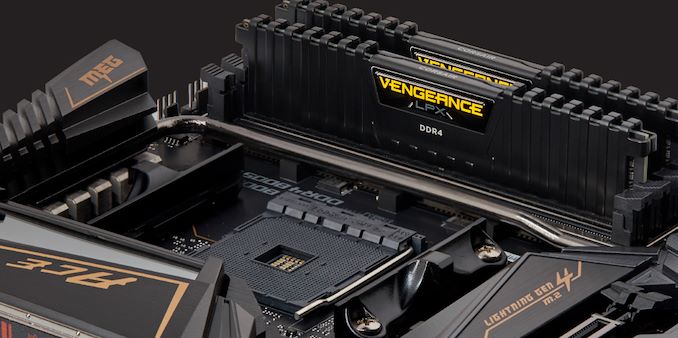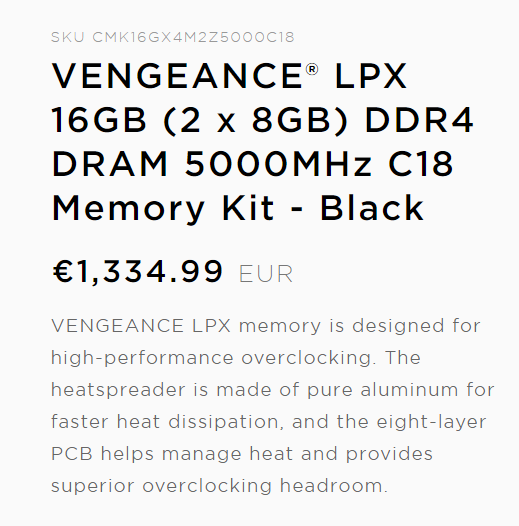Corsair 16GB DDR4-5000 Vengeance LPX Memory Kit: Built for AMD Ryzen 3000 and MSI
by Anton Shilov on October 11, 2019 11:00 AM EST
The high-tech industry loves milestones that are round numbers, be it frequency, number of cores, transistor count or something else. It is not that extra 100 MHz – 200 MHz or a couple of additional CPU cores radically improve performance or user experience these days, but because milestones symbolize an achievement, a new height from where we will go and hit the next ones. Today, the industry has reached a milestone as Corsair introduced the industry’s first commercial DDR4-5000 memory modules. We saw numerous companies 'promote' DDR4-5000 earlier this year at Computex, but none were seriously considering bringing them to retail. Corsair is the first.
Corsair’s dual-channel Vengeance LPX DDR4-5000 (CMK16GX4M2Z5000C18) memory kit comprises two 8 GB unbuffered modules featuring a CL18 26-26-46 latency and a 1.5V voltage. The memory modules use Micron’s cherry-picked memory ICs and use a custom 8-layer PCB from Corsair. The enthusiast grade modules are equipped with aluminum heat spreaders, and are compatible with Corsair’s Vengeance Airflow fan to maximize their cooling.
Corsair says that its Vengeance LPX DDR4-5000 (CMK16GX4M2Z5000C18) memory kit was tuned to hit the desired data transfer rate on high-end platforms based on AMD’s Ryzen 3000 processor and X570 chipset. To be more precise the modules were developed and validated on MSI’s X570 Godlike, MEG X570 Ace, MEG X570 Unify, and Prestige X570 Creation motherboards.
It is unclear how well the modules will work in DDR4-5000 mode when used with other platforms. In any case, keep in mind that modules require 1.5 Volts, which is a whopping 25% increase over standard DDR4 voltage, so they have to be installed in an enthusiast-grade mainboard with a quality and clean memory power supply. In order to reach the DDR4-5000 mode requires some user intervention beyond just setting the XMP profile: to set up the right settings Corsair recommends to check out its Ryzen 3000 memory overclocking guide.
Designed for die-hard performance enthusiasts, overclockers, and benchmarkers, Corsair’s dual-channel 16GB Vengeance LPX DDR4-5000 memory kit is certainly not cheap at all. The company sells it for a sizeable $1,224.99 in the USA ($76.56/GB) and for €1,334.99 in Europe.
Corsair says that there are limited review samples available - if we get one in to test, what would you like to see?
Related Reading
- Corsair Reveals Vengeance LPX DDR4-4866 Memory Kit
- GeIL Demonstrates DDR4-5000 Memory Modules: Not for Sale
- G.Skill Announces DDR4-4800 and DDR4-4500 Kits for Z390 Boards
- Corsair Unveils 32 GB Vengeance LPX DDR4 DIMMs, 64 GB & 128 GB Dual-Channel Kits
Source: Corsair














38 Comments
View All Comments
Cooe - Saturday, October 12, 2019 - link
This is false. The gains are ridiculously substantial! With say a Ryzen 5 3400G, you are looking at near 1-1-1 gaming performance increase to memory bandwidth increase. Just going from 2133MHz to 3200MHz increases performance by like 20-30%.Korguz - Monday, October 14, 2019 - link
is there an article or review you can refer to ?lightningz71 - Tuesday, October 15, 2019 - link
Of course, there are substantial gains to be had going from 2133 to 3200, however, the gains start to diminish rapidly after that. The CU count and speed on the APUs is tailored to the expected memory bandwidth. I expect that the next APU, Renoir, will retain 11-12 VEGA2 CUs, perhaps even a few more with LOWER clocks for power savings. They will likely target supporting 3200-3600 speed DDR4, which is still highly restrictive.Going forward, I suspect that very high speed DDR4 sticks will be the same situation as very high end DDR3 sticks were, since the standard is going to be on the way out, they will never hit high enough production numbers to make them cost effective. Maybe we'll see DDR4-4200 hit decent volume and decent prices, and there will be an APU that supports those speeds, but that's still not a whole lot of GPU bandwidth.
MrEcho - Friday, October 11, 2019 - link
I wonder when AMD will put a L4 onto the CPU package. It seems with all these cores, memory fetch is becoming a very real issue again. Something like 1-2GB as an L4/L3 on its own silicon, and with their new standalone IO chip, it could be done.PeachNCream - Friday, October 11, 2019 - link
Intel had Crystalwell thing on some CPUs and although it was mainly intended to support the iGPU, it was also shared with the CPU cores as a last layer cache. In CPU benchmarks, it didn't make a lot of difference. Obviously we are talking about different processor architectures and the chiplet configuration is different too, but performance from caches rapidly diminish with capacity. I don't think there would be a need to even go as big as 1GB to find a sweet spot in performance versus cost. 128-256GB of fast/low latency memory would probably do the trick, but that's assuming the existing caches are already a bottleneck. I recall AMD went pretty big with cache on the Zen-derived cores so it may not even be a performance problem as-is unless you're also suggesting said large cache also support integrated graphics as Intel did with the Iris/Crystalwell combination. iGPUs tend to be starved for memory bandwidth (nevermind the shared thermal/cooling situation) and with AMD usually packing a comparably quick graphics package compared to Intel, giving said GPU more bandwidth may help. It also could endanger sales of dGPUs if performance reaches high enough so there might not be an incentive to implement such a feature when AMD would likely rather sell you a dedicated Radeon card.porina - Saturday, October 12, 2019 - link
I loved the Broadwell desktop CPUs because of the L4. In ram intensive compute tasks, it provided practically unlimited bandwidth and they ended up faster than Skylake, which has higher IPC but was unable to be kept fed adequately unless you had serious ram for the time. I kinda see similar happening with the generous L3 in Zen 2 CPUs. It helps a lot, although currently with the split L3 per CCX that hinders performance than if it were unified per CCD. The cache also helps mitigate against the crippled write bandwidth. I can't see either company offering more channels at consumer level, so big caches will be the way to go to scale to higher core counts.Rudde - Saturday, October 12, 2019 - link
There are rumors that Zen 3 has unified L3 per CCD.FreckledTrout - Friday, October 11, 2019 - link
If they move from 14nm to TSMC's 7nm for the IO die they would have a lot of extra die space I could see 256MB of L4.lightningz71 - Tuesday, October 15, 2019 - link
Maybe, but that's unlikely. The restrictive IF bandwidth will limit it's performance impact per CCD, it would only hide a little latency. In fact, it'll add a layer of latency as the IO die will need to decide if the requested memory area has been locally cached, or is in the DRAM itself. It would have to be massive to make a measurable impact.evanh - Saturday, October 12, 2019 - link
Well, the zen2 I/O dies have a large amount of real-estate with no apparent need. AMD is pretty quiet on what is consuming all those transistors. It might not qualify as an actual cache but I suspect there is a lot of block RAM in there.